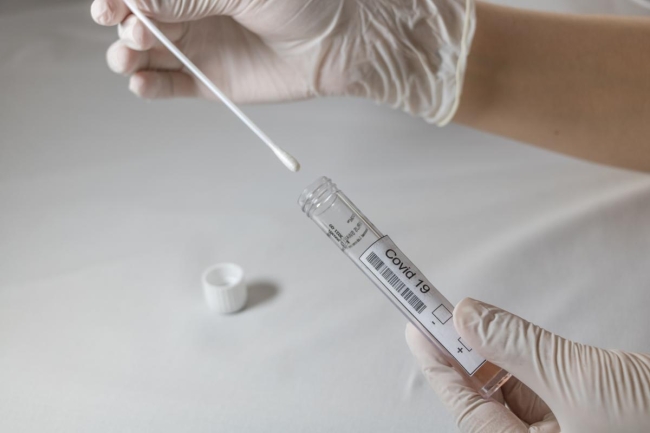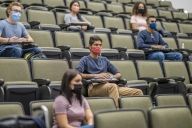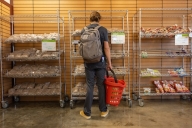You have /5 articles left.
Sign up for a free account or log in.

Experts say COVID-19 testing continues to have an important role due to breakthrough cases.
Okan Celik/iStock/Getty Images Plus
Since the earliest days of the COVID-19 pandemic, colleges and universities have played a key role in providing testing and other health resources—not just on campuses but in their local communities. With cases spiking as the start of the third pandemic year approaches, many colleges are leveraging their resources and brainpower in innovative new ways to increase their support of local communities struggling to survive an ever-evolving disease.
One crucial component in the fight to contain COVID-19 has been testing, which has prompted numerous colleges to develop testing sites on campus or in the broader community, including historically underserved areas that often have populations of exposed essential workers.
Colleges as Testing Hubs
“Looking at how this virus impacted individuals, we were very concerned about making sure that individuals in our surrounding community had access to testing,” said Tanya Tatum, director of student health services at Florida A&M University in Tallahassee.
Florida A&M set up a testing site on campus in April 2021, initially serving 200 people per day. That capacity was soon expanded, and by now the college, which enrolls around 9,000 students, has administered more than 586,000 COVID tests. That’s all part of the mission for the historically Black college in a minority neighborhood.
“We wanted to make sure that the African American community, minorities, the lower socioeconomic part of the community here in Tallahassee, had access to testing services,” Tatum said. “We’re now probably the main testing site in town. We had people come here from all over in the beginning. We had people coming from surrounding counties, other states.”
Arizona State University also launched testing sites in the early days of the pandemic. Now, nearly two years in, ASU has processed 1.2 million tests for COVID-19.
“When we first started to open up our testing in April of 2020, the first groups we started testing were high-priority groups in the community,” said Joshua LaBaer, executive director of the Biodesign Institute at ASU, who noted that essential workers were among the very first tested.
Testing at ASU continues; the university has partnered with the state to provide COVID-19 testing sites for underserved communities in high-need areas. After all, LaBaer said, testing remains crucial as coronavirus continues to spread despite the deployment of vaccines.
“The best way to prevent spread right now is to get regularly tested. You cannot rely on the fact that you’ve been vaccinated or that you’ve had it before to know that you’re not going to ever get it again, because lots of people are getting breakthrough cases,” LaBaer said.
Colleges as Testing Innovators
In addition to serving as testing sites, some colleges are also playing the role of innovators, developing new technologies in an effort to contain COVID-19. ASU is one such example, administering saliva-based COVID-19 tests developed by its own Biodesign Institute.
The tests are essentially comprised of a screw-top tube and a straw. Users spit through the straw into the tube, which LaBaer says offers a useful saliva sample that can then be processed through a lab with a turnaround time of 24 to 48 hours. The simplicity of the design, he adds, made it easy to mass-produce tests even amid ongoing supply chain issues.
The design is also less invasive than common nasal swab tests, LaBaer said.
As ASU was developing its saliva-based tests, scientists across the country at Brown University were also working on an alternative COVID-19 test.
Will Fairbrother, a biology professor at Brown, developed a test he’s named “The Bubbler,” which focuses on breath samples, making it less invasive than nasal tests. The Bubbler, simplified, is akin to a water pipe that treats human breath as a biosample.
“The Bubbler is just a simple diagnostic test for COVID,” Fairbrother said. “It’s a handheld device, and you breathe through a straw and it bubbles through an enzymatic reaction mixture that’s in this kind of oil emulsion. If you have COVID in your breath, it directly converts the RNA into DNA, which is analyzed by a traditional PCR [polymerase chain reaction] method.”
In addition to exhaled breath, The Bubbler can also sample environmental air. That means it could have uses in hospitals and office buildings to determine the presence of COVID-19.
After a clinical trial in an area hospital, Fairbrother published a paper on The Bubbler. Now he hopes to bring this breath-based test to the masses and is applying for an emergency use authorization through the Food and Drug Administration, a process that he says is ongoing.
Even if COVID-19 moves from the pandemic to the endemic stage, testing will likely remain.
“It wouldn’t surprise me at all if there was a role for testing that extends into the future,” Fairbrother said.
Colleges as Good Neighbors
The effects of the coronavirus were felt in many college towns in the early days of the pandemic as colleges shifted to remote instruction en masse, leaving some cities devoid of a population that serves as a vital economic engine. The importance of the town-gown connection has perhaps never been more obvious as restaurants and storefronts in college towns struggle to rebound. But beyond the economic spark, experts note that colleges offer value to local communities in many other ways, particularly as resource centers and partners in the health of the region.
“FAMU takes service to the community very seriously. It’s part of who we are and what we do,” Tatum said. “We’re a historically Black college and have a calling to address issues and concerns for minority and underserved communities. This is all part of our mission.”
At ASU, LaBaer echoes those sentiments. Colleges typically make for good neighbors, he said, emphasizing the importance of adding to the community that institutions call their home.
“We are part of the communities that we live in,” LaBaer said. “And we have a responsibility, in my view, to participate in that community. We’re not just ivory towers where knowledge gets created and gets published in obscure journals. We have a responsibility to be part of that community and to share that knowledge locally with that community.”








